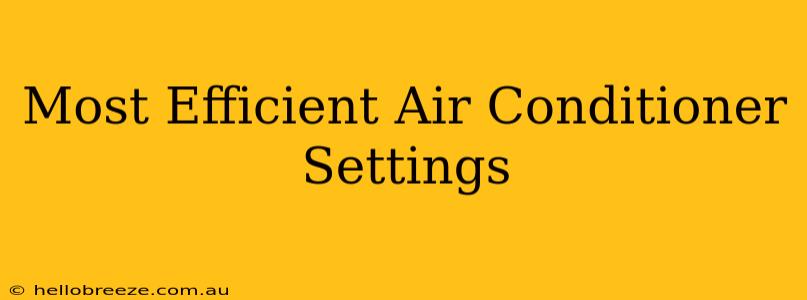Summer's heat can be brutal, but keeping your home cool shouldn't break the bank. Learning how to optimize your air conditioner settings is key to achieving both comfort and energy efficiency. This guide explores the most efficient air conditioner settings to help you stay cool while saving money on your energy bills.
Understanding Your Air Conditioner
Before diving into specific settings, it's crucial to understand how your AC unit works. Most modern units have a programmable thermostat offering various options for controlling temperature, fan speed, and operational modes. Knowing these functionalities empowers you to make informed decisions leading to maximum efficiency.
Key Features to Master:
- Thermostat Programming: Most modern thermostats allow for programmable schedules, automatically adjusting temperatures based on your daily routine. This prevents your AC from running unnecessarily when you're away or asleep.
- Fan Settings: Understanding the difference between "Auto" and "On" is vital. "Auto" only runs the fan when the compressor is actively cooling, while "On" runs the fan continuously. "Auto" is generally more energy-efficient unless you want continuous air circulation.
- Cool vs. Heat Pump Modes: If you have a heat pump system, ensure you're using the "Cool" mode during summer. Selecting the correct mode is essential for optimal efficiency.
- Energy-Saving Modes: Many AC units offer an "Energy Saver" or "Eco" mode. This often involves slightly raising the set temperature and potentially adjusting the fan speed to conserve energy.
Optimizing Your Air Conditioner Settings for Efficiency
Now let's explore the specific settings that will maximize your AC's efficiency and minimize energy waste:
1. Set Your Thermostat Wisely:
The ideal temperature setting is often debated, but generally, 78°F (26°C) is a good starting point for most people. Every degree lower increases energy consumption significantly. Consider raising the temperature a few degrees when you're away from home or asleep.
2. Utilize Programmable or Smart Thermostats:
These thermostats offer significant savings by automatically adjusting temperatures based on your schedule. Program it to raise the temperature when you're at work or asleep, and lower it before you return home.
3. Choose the Right Fan Setting:
Generally, "Auto" is the most energy-efficient option. Continuous fan operation ("On") consumes extra energy. However, if you prefer a gentle breeze even when the compressor isn't running, consider using "On" sparingly.
4. Maintain Regular Maintenance:
Regular maintenance is crucial for optimal efficiency. Clean or replace your air filters regularly (at least every 3 months), and schedule professional maintenance annually to ensure your unit is running at peak performance. A clogged filter restricts airflow, forcing your AC to work harder.
5. Seal Air Leaks:
Prevent cooled air from escaping by sealing air leaks around windows and doors. Caulk, weather stripping, and window insulation can significantly improve your AC's efficiency.
6. Consider Window Treatments:
Utilize curtains, blinds, or shades to block out direct sunlight, reducing the heat load on your AC. This minimizes the amount of work your air conditioner needs to do, resulting in energy savings.
Beyond Settings: Additional Tips for Efficiency
- Use ceiling fans: Ceiling fans circulate air, making you feel cooler, allowing you to raise the thermostat setting without compromising comfort.
- Cook outside: Cooking generates heat, which adds to the load on your AC. Grilling or using a slow cooker outdoors reduces your AC's workload.
- Close vents in unused rooms: Restricting airflow to unused rooms reduces the amount of space your AC needs to cool.
By implementing these tips and using the most efficient air conditioner settings, you can enjoy a comfortably cool home without straining your budget or the environment. Remember, small adjustments can lead to significant savings over time.

